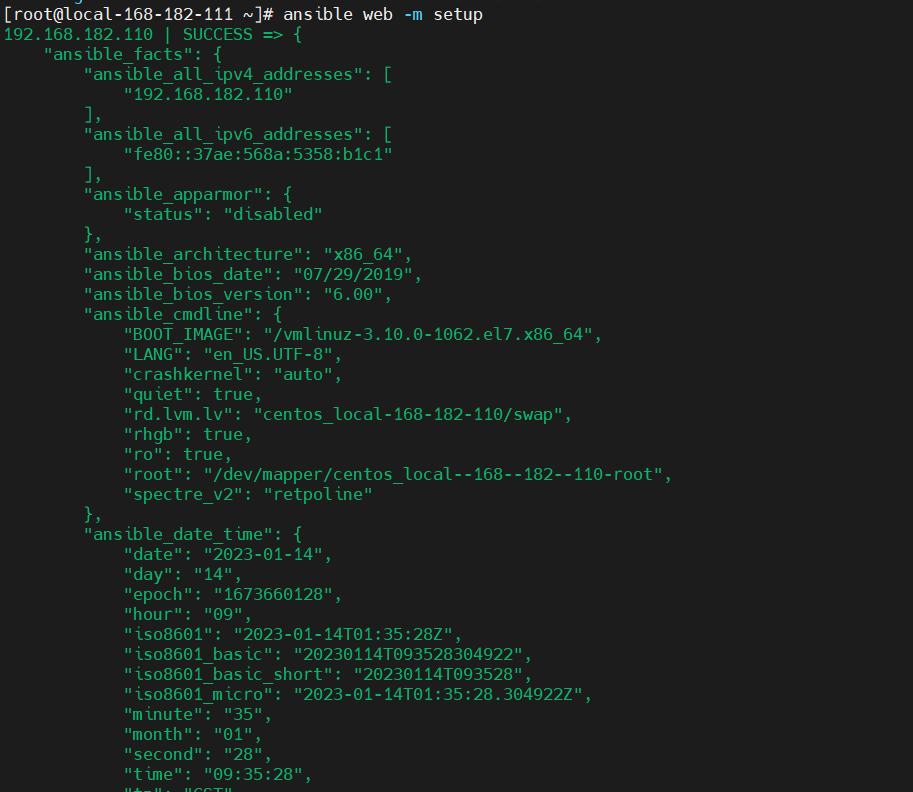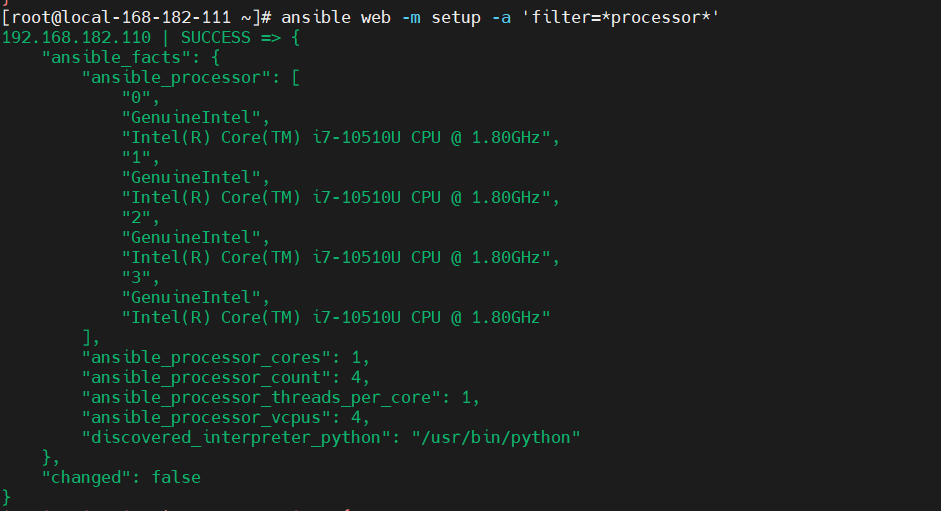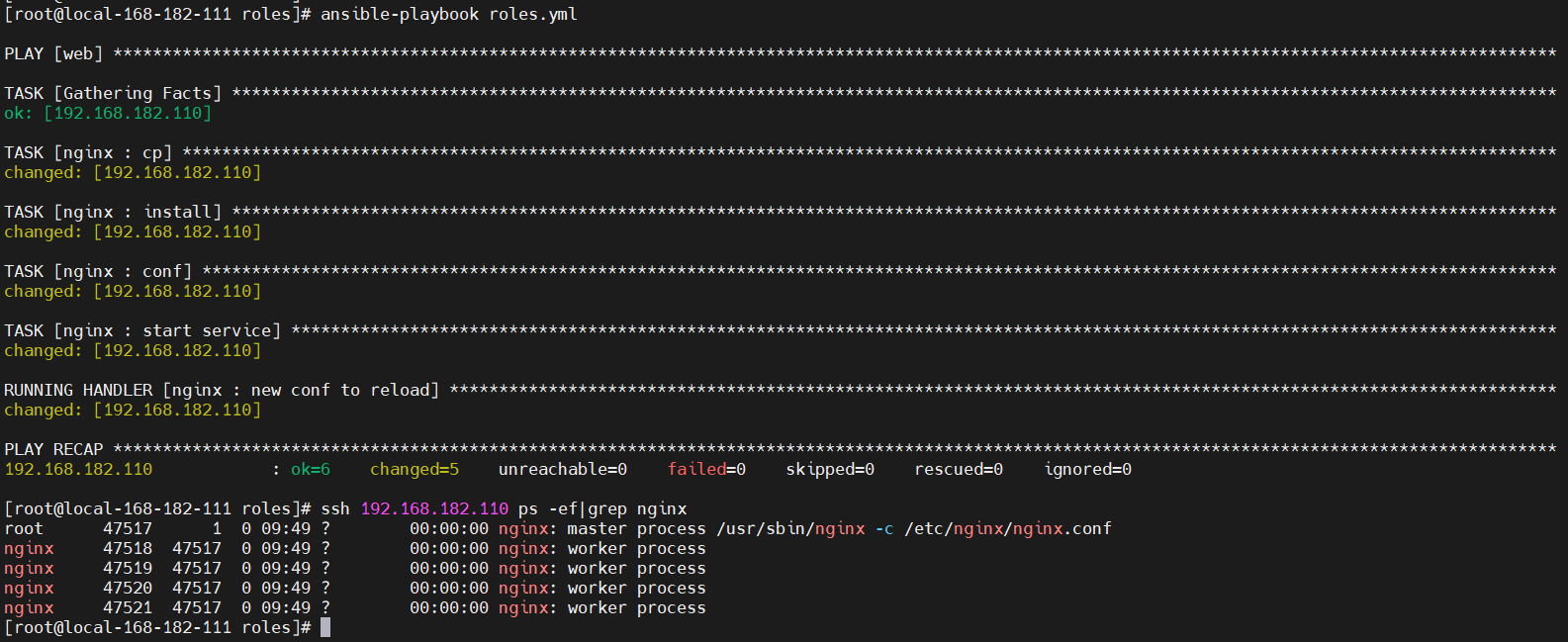一、概述
- playbook与ad-hoc相比,是一种完全不同的运用ansible的方式,类似与saltstack的state状态文件。ad-hoc无法持久使用,playbook可以持久使用。
- playbook是由一个或多个play组成的列表,play的主要功能在于将事先归并为一组的主机装扮成事先通过ansible中的task定义好的角色。
- 从根本上来讲,所谓的task无非是调用ansible的一个module。将多个play组织在一个playbook中,即可以让它们联合起来按事先编排的机制完成某一任务。
参考文档:https://ansible-tran.readthedocs.io/en/latest/docs/playbooks.html
Ansible 的基础介绍和环境部署可以参考我这篇文章:Ansible 介绍与实战操作演示

二、playbook 核心元素
- Hosts执行的远程主机列表
- Tasks任务集
- Varniables内置变量或自定义变量在playbook中调用
- Templates模板,即使用模板语法的文件,比如配置文件等
- Handlers和notity结合使用,由特定条件触发的操作,满足条件方才执行,否则不执行
- Tags标签,指定某条任务执行,用于选择运行playbook中的部分代码。
三、playbook 语法(yaml)
- playbook使用yaml语法格式,后缀可以是yaml,也可以是yml。
- YAML( /ˈjæməl/ )参考了其他多种语言,包括:XML、C语言、Python、Perl以及电子邮件格式RFC2822,Clark Evans在2001年5月在首次发表了这种语言,另外Ingy döt Net与OrenBen-Kiki也是这语言的共同设计者。
- YAML格式是类似JSON的文件格式。YAML用于文件的配置编写,JSON多用于开发设计。
1)YAML 介绍
1、YAML 格式如下
- 文件的第一行应该以“---”(三个连字符)开始,表明YAML文件的开始。
- 在同一行中,#之后的内容表示注释,类似于shell,python和ruby。
- YAML中的列表元素以“-”开头并且跟着一个空格。后面为元素内容。
- 同一个列表之中的元素应该保持相同的缩进,否则会被当做错误处理。
- play中hosts、variables、roles、tasks等对象的表示方法都是以键值中间以“:”分隔表示,并且“:”之后要加一个空格。
2、playbooks yaml配置文件解释
Hosts:运行指定任务的目标主机 remoute_user:在远程主机上执行任务的用户; sudo_user: tasks:任务列表 tasks的具体格式: tasks: - name: TASK_NAME module: arguments notify: HANDLER_NAME handlers: - name: HANDLER_NAME module: arguments ##模块,模块参数: 格式如下: (1)action: module arguments (2) module: arguments 注意:shell和command模块后直接加命令,而不是key=value类的参数列表 handlers:任务,在特定条件下触发;接受到其他任务的通知时被触发;
3、示例
--- - hosts: web remote_user: root tasks: - name: install nginx##安装模块,需要在被控主机里加上nginx的源 yum: name=nginx state=present - name: copy nginx.conf##复制nginx的配置文件过去,需要在本机的/tmp目录下编辑nginx.conf copy: src=/tmp/nginx.conf dest=/etc/nginx/nginx.conf backup=yes notify: reload#当nginx.conf发生改变时,通知给相应的handlers tags: reloadnginx#打标签 - name: start nginx service#服务启动模块 service: name=nginx state=started tags: startnginx#打标签 handlers: - name: reload service: name=nginx state=restarted
2)variables 变量
variables变量有四种定义方法。如下:
1、facts:可以直接调用
ansible中有setup模块,这个模块就是通过facts组件来实现的,主要是节点本身的一个系统信息,bios信息,网络,硬盘等等信息。这里的variables也可以直接调用facts组件的facters我们可以使用setup模块来获取,然后直接放入我们的剧本之中调用即可。
ansible web -m setup

常用的几个参数:
ansible_all_ipv4_addresses # ipv4的所有地址 ansible_all_ipv6_addresses # ipv6的所有地址 ansible_date_time # 获取到控制节点时间 ansible_default_ipv4 # 默认的ipv4地址 ansible_distribution # 系统 ansible_distribution_major_version # 系统的大版本 ansible_distribution_version # 系统的版本号 ansible_domain #系统所在的域 ansible_env #系统的环境变量 ansible_hostname #系统的主机名 ansible_fqdn #系统的全名 ansible_machine #系统的架构 ansible_memory_mb #系统的内存信息 ansible_os_family # 系统的家族 ansible_pkg_mgr # 系统的包管理工具 ansible_processor_cores #系统的cpu的核数(每颗) ansible_processor_count #系统cpu的颗数 ansible_processor_vcpus #系统cpu的总个数=cpu的颗数*CPU的核数 ansible_python # 系统上的python
搜索
ansible web -m setup -a 'filter=*processor*'

2、用户自定义变量
自定义变量有两种方式
- 通过命令行传入
ansible-playbook命令行中的 -e VARS,--extra-vars VARS,这样就可以直接把自定义的变量传入
使用playbook定义变量,实例如下:
---
- hosts: web
remote_user: root
tasks:
- name: install {{ rpmname }}
yum: name={{ rpmname }} state=present
- name: copy {{ rpmname }}.conf
copy: src=/tmp/{{ rpmname }}.conf dest=/etc/{{ rpmname }}/{{ rpmname }}.conf backup=yes
notify: reload
tags: reload{{ rpmname }}
- name: start {{ rpmname }} service
service: name={{ rpmname }} state=started
tags: start{{ rpmname }}
handlers:
- name: reload
service: name={{ rpmname }} state=restarted使用:
ansible-playbook nginx.yml -e rpmname=keepalived ansible-playbook nginx.yml --extra-vars rpmname=keepalived
- 在playbook中定义变量
##在playbook中定义变量如下: vars: - var1: value1 - var2: value2
使用:
---
- hosts: web
remote_user: root
vars:
- rpmname: keepalived
tasks:
- name: install {{ rpmname }}
yum: name={{ rpmname }} state=present
- name: copy {{ rpmname }}.conf
copy: src=/tmp/{{ rpmname }}.conf dest=/etc/{{ rpmname }}/{{ rpmname }}.conf backup=yes
notify: reload
tags: reload{{ rpmname }}
- name: start {{ rpmname }} service
service: name={{ rpmname }} state=started
tags: start{{ rpmname }}
handlers:
- name: reload
service: name={{ rpmname }} state=restarted3、通过roles传递变量
下面介绍roles会使用roles传递变量,小伙伴可以翻到下面看详解讲解。
4、 Host Inventory
可以在主机清单中定义,方法如下:
#向不同的主机传递不同的变量 IP/HOSTNAME varaiable=value var2=value2 #向组中的主机传递相同的变量 [groupname:vars] variable=value
3)流程控制
1、用when 来表示的条件判断
- hosts: web remote_user: root#代表用root用户执行,默认是root,可以省略 tasks: - name: createfile copy: content="test3" dest=/opt/p1.yml when: a=='3' - name: createfile copy: content="test4" dest=/opt/p1.yml when: a=='4'
如果a"3",就将“test3”,写入到web组下被管控机的/opt/p1.yml中,
如果a"4",就将“test4”,写入到web组下被管控机的/opt/p1.yml中。
执行
# 语法校验 ansible-playbook--syntax-check p1.yml #执行 ansible-playbook -e 'a="3"' p1.yml
2、标签(只执行配置文件中的一个任务)
- hosts: web tasks: - name: installnginx yum: name=nginx - name: copyfile copy: src=/etc/nginx/nginx.conf dest=/etc/nginx/nginx.conf tags: copyfile - name: start service: name=nginx static=restarted
执行
# 语法校验 ansible-playbook--syntax-check p2.yml #执行 ansible-playbook -t copyfile p2.yml
3、循环 with_items
创建三个用户
- hosts: web
tasks:
- name: createruser
user: name={{ item }}
with_items:
- shy1
- shy2
- shy3
- name: creategroup
group: name={{ item }}
with_items:
- group1
- group2
- group3 执行
#语法校验 ansible-playbook--syntax-check p3.yml #执行 ansible-playbook p3.yml
4、循环嵌套(字典)
用户shy1的属组是group1,用户shy2的属组是group2,用户shy3的属组是group3
- hosts: web
tasks:
- name: creategroup
group: name={{item}}
with_items:
- group3
- group4
- group5
- name: createuser
user: name={{item.user}} group={{item.group}}
with_items:
- {'user': shy3,'group': group3}
- {'user': shy4,'group': group4}
- {'user': shy5,'group': group5}执行
#语法校验 ansible-playbook--syntax-check p4.yml #执行 ansible-playbook p4.yml
4)模板 templates
- 模板是一个文本文件,嵌套有脚本(使用模板编程语言编写)
- Jinja2是python的一种模板语言,以Django的模板语言为原本
该模板支持:
字符串:使用单引号或双引号;
数字:整数,浮点数;
列表:[item1, item2, ...]
元组:(item1, item2, ...)
字典:{key1:value1, key2:value2, ...}
布尔型:true/false
算术运算:
+, -, *, /, //, %, **
比较操作:
==, !=, >, >=, <, <=
逻辑运算:
and, or, not- 通常模板都是通过引用变量来运用的
【示例】
1、定义模板
usernginx; #设置nginx服务的系统使用用户
worker_processes{{ ansible_processor_vcpus }}; #工作进程数
error_log/var/log/nginx/error.log warn; #nginx的错误日志
pid/var/run/nginx.pid; #nginx启动时候的pid
events {
worker_connections1024; #每个进程允许的最大连接数
}
http { #http请求配置,一个http可以包含多个server
#定义 Content-Type
include /etc/nginx/mime.types;
default_typeapplication/octet-stream;
#日志格式 此处main与access_log中的main对应
#$remote_addr:客户端地址
#$remote_user:http客户端请求nginx认证的用户名,默认不开启认证模块,不会记录
#$timelocal:nginx的时间
#$request:请求method + 路由 + http协议版本
#status:http reponse 状态码
#body_bytes_sent:response body的大小
#$http_referer:referer头信息参数,表示上级页面
#$http_user_agent:user-agent头信息参数,客户端信息
#$http_x_forwarded_for:x-forwarded-for头信息参数
log_formatmain'$http_user_agent' '$remote_addr - $remote_user [$time_local] "$request" '
'$status $body_bytes_sent "$http_referer" '
'"$http_user_agent" "$http_x_forwarded_for"';
#访问日志,后面的main表示使用log_format中的main格式记录到access.log中
access_log/var/log/nginx/access.logmain;
#nginx的一大优势,高效率文件传输
sendfileon;
#tcp_nopush on;
#客户端与服务端的超时时间,单位秒
keepalive_timeout65;
#gzipon;
server { #http服务,一个server可以配置多个location
listen {{ nginxport }}; #服务监听端口
server_namelocalhost; #主机名、域名
#charset koi8-r;
#access_log/var/log/nginx/host.access.logmain;
location / {
root /usr/share/nginx/html; #页面存放目录
indexindex.html index.htm; #默认页面
}
#error_page404/404.html;
# 将500 502 503 504的错误页面重定向到 /50x.html
error_page 500 502 503 504/50x.html;
location = /50x.html { #匹配error_page指定的页面路径
root /usr/share/nginx/html; #页面存放的目录
}
# proxy the PHP scripts to Apache listening on 127.0.0.1:80
#
#location ~ \.php$ {
#proxy_pass http://127.0.0.1;
#}
# pass the PHP scripts to FastCGI server listening on 127.0.0.1:9000
#
#location ~ \.php$ {
#root html;
#fastcgi_pass 127.0.0.1:9000;
#fastcgi_indexindex.php;
#fastcgi_paramSCRIPT_FILENAME/scripts$fastcgi_script_name;
#includefastcgi_params;
#}
# deny access to .htaccess files, if Apache's document root
# concurs with nginx's one
#
#location ~ /\.ht {
#denyall;
#}
}
include /etc/nginx/conf.d/*.conf;
}2、定义yaml编排
---
- hosts: web
remote_user: root
vars:
- rpmname: nginx
- nginxport: 8088
tasks:
- name: install {{ rpmname }}
yum: name={{ rpmname }} state=present
- name: copy {{ rpmname }}.conf
copy: src=/tmp/{{ rpmname }}.conf dest=/etc/{{ rpmname }}/{{ rpmname }}.conf backup=yes
notify: reload
tags: reload{{ rpmname }}
- name: start {{ rpmname }} service
service: name={{ rpmname }} state=started
tags: start{{ rpmname }}
handlers:
- name: reload
service: name={{ rpmname }} state=restarted使用
##使用reloadnginx标签,重新加载剧本
copy与template的区别
- copy模块不替代参数,template模块替代参数
- template的参数几乎与copy的参数完全相同
5)handlers(触发事件)
notify:触发 handlers:触发的动作
使用上场景:修改配置文件时
【示例】 正常情况时handlers是不会执行的
- hosts: web tasks: - name: installredis yum: name=redis - name: copyfile template: src=redis.conf dest=/etc/redis.conf tags: copyfile notify: restart - name: start service: name=redis state=started handlers: - name: restart service: name=redis
执行
ansible-playbook -t copyfile p6.yml
6)roles
1、roles介绍与优势
一般情况下将roles写在/etc/ansible/roles中,也可以写在其他任意位置(写在其他位置要自己手动建立一个roles文件夹)
- 对于以上所有方式有个缺点就是无法实现同时部署web、database、keepalived等不同服务或者不同服务器组合不同的应用就需要写多个yaml文件,很难实现灵活的调用
- roles用于层次性,结构化地组织playbook。roles能够根据层次结果自动装载变量文件、tasks以及handlers等。
- 要使用roles只需要在playbook中使用include指令即可。
- 简单来讲,roles就是通过分别将变量(vars)、文件(files)、任务(tasks)、模块(modules)以及处理器(handlers)放置于单独的目录中,并且可以便捷的include它们地一种机制。
- 角色一般用于基于主机构建服务的场景中,但是也可以用于构建守护进程等场景中。4
2、目录结构
创建目录
mkdir -pv ./{nginx,mysql,httpd}/{files,templates,vars,tasks,handlers,meta,default}
- roles/
- mysql/:mysql服务的yml文件
- httpd/:apached服务的yml文件
- nginx/:nginx服务的yml文件
- files/:存储由copy或者script等模块调用的文件或者脚本;
- tasks/:此目录中至少应该有一个名为main.yml的文件,用于定义各个task;其他文件需要由main.yml进行包含调用;
- handlers/:此目录中至少应该有一个名为main.yml的文件,用于定义各个handler;其他文件需要由main.yml进行包含调用;
- vars/:此目录至少应该有一个名为main,yml的文件,用于定义各个variable;其他的文件需要由main.yml进行包含调用;
- templates/:存储由templates模块调用的模板文件;
- meta/:此目录中至少应该有一个名为main.yml的文件,定义当前角色的特殊设定以及依赖关系,其他文件需要由main.yml进行包含调用;
- default/:此目录至少应该有一个名为main.yml的文件,用于设定默认变量;
3、实战操作
【1】创建目录
mkdir -pv ./{nginx,mysql,httpd}/{files,templates,vars,tasks,handlers,meta,default}【2】定义配置文件
先下载nginx rpm部署包
# 下载地址:http://nginx.org/packages/centos/7/x86_64/RPMS/ wget http://nginx.org/packages/centos/7/x86_64/RPMS/nginx-1.18.0-1.el7.ngx.x86_64.rpm -O nginx/files/nginx-1.18.0-1.el7.ngx.x86_64.rpm
- nginx/tasks/main.yml
- name: cp copy: src=nginx-1.18.0-1.el7.ngx.x86_64.rpm dest=/tmp/nginx-1.18.0-1.el7.ngx.x86_64.rpm - name: install yum: name=/tmp/nginx-1.18.0-1.el7.ngx.x86_64.rpm state=latest - name: conf template: src=nginx.conf.j2 dest=/etc/nginx/nginx.conf tags: nginxconf notify: new conf to reload - name: start service service: name=nginx state=started enabled=true
- nginx/templates/nginx.conf.j2
usernginx; #设置nginx服务的系统使用用户
worker_processes{{ ansible_processor_vcpus }}; #工作进程数
error_log/var/log/nginx/error.log warn; #nginx的错误日志
pid/var/run/nginx.pid; #nginx启动时候的pid
events {
worker_connections1024; #每个进程允许的最大连接数
}
http { #http请求配置,一个http可以包含多个server
#定义 Content-Type
include /etc/nginx/mime.types;
default_typeapplication/octet-stream;
#日志格式 此处main与access_log中的main对应
#$remote_addr:客户端地址
#$remote_user:http客户端请求nginx认证的用户名,默认不开启认证模块,不会记录
#$timelocal:nginx的时间
#$request:请求method + 路由 + http协议版本
#status:http reponse 状态码
#body_bytes_sent:response body的大小
#$http_referer:referer头信息参数,表示上级页面
#$http_user_agent:user-agent头信息参数,客户端信息
#$http_x_forwarded_for:x-forwarded-for头信息参数
log_formatmain'$http_user_agent' '$remote_addr - $remote_user [$time_local] "$request" '
'$status $body_bytes_sent "$http_referer" '
'"$http_user_agent" "$http_x_forwarded_for"';
#访问日志,后面的main表示使用log_format中的main格式记录到access.log中
access_log/var/log/nginx/access.logmain;
#nginx的一大优势,高效率文件传输
sendfileon;
#tcp_nopush on;
#客户端与服务端的超时时间,单位秒
keepalive_timeout65;
#gzipon;
server { #http服务,一个server可以配置多个location
listen {{ nginxport }}; #服务监听端口
server_namelocalhost; #主机名、域名
#charset koi8-r;
#access_log/var/log/nginx/host.access.logmain;
location / {
root /usr/share/nginx/html; #页面存放目录
indexindex.html index.htm; #默认页面
}
#error_page404/404.html;
# 将500 502 503 504的错误页面重定向到 /50x.html
error_page 500 502 503 504/50x.html;
location = /50x.html { #匹配error_page指定的页面路径
root /usr/share/nginx/html; #页面存放的目录
}
# proxy the PHP scripts to Apache listening on 127.0.0.1:80
#
#location ~ \.php$ {
#proxy_pass http://127.0.0.1;
#}
# pass the PHP scripts to FastCGI server listening on 127.0.0.1:9000
#
#location ~ \.php$ {
#root html;
#fastcgi_pass 127.0.0.1:9000;
#fastcgi_indexindex.php;
#fastcgi_paramSCRIPT_FILENAME/scripts$fastcgi_script_name;
#includefastcgi_params;
#}
# deny access to .htaccess files, if Apache's document root
# concurs with nginx's one
#
#location ~ /\.ht {
#denyall;
#}
}
include /etc/nginx/conf.d/*.conf;
}- nginx/vars/main.yml
nginxport: 9999
- nginx/handlers/main.yml
- name: new conf to reload service: name=nginx state=restarted
- 定义剧本文件(roles.yml)
- hosts: web remote_user: root roles: - nginx
最后的目录结构如下:

执行
ansible-playbook roles.yml

以上是Ansible Playbook 讲解与实战操作的详细内容。更多信息请关注PHP中文网其他相关文章!

热AI工具

Undresser.AI Undress
人工智能驱动的应用程序,用于创建逼真的裸体照片

AI Clothes Remover
用于从照片中去除衣服的在线人工智能工具。

Undress AI Tool
免费脱衣服图片

Clothoff.io
AI脱衣机

AI Hentai Generator
免费生成ai无尽的。

热门文章

热工具

SecLists
SecLists是最终安全测试人员的伙伴。它是一个包含各种类型列表的集合,这些列表在安全评估过程中经常使用,都在一个地方。SecLists通过方便地提供安全测试人员可能需要的所有列表,帮助提高安全测试的效率和生产力。列表类型包括用户名、密码、URL、模糊测试有效载荷、敏感数据模式、Web shell等等。测试人员只需将此存储库拉到新的测试机上,他就可以访问到所需的每种类型的列表。

SublimeText3汉化版
中文版,非常好用

禅工作室 13.0.1
功能强大的PHP集成开发环境

Atom编辑器mac版下载
最流行的的开源编辑器

MinGW - 适用于 Windows 的极简 GNU
这个项目正在迁移到osdn.net/projects/mingw的过程中,你可以继续在那里关注我们。MinGW:GNU编译器集合(GCC)的本地Windows移植版本,可自由分发的导入库和用于构建本地Windows应用程序的头文件;包括对MSVC运行时的扩展,以支持C99功能。MinGW的所有软件都可以在64位Windows平台上运行。





